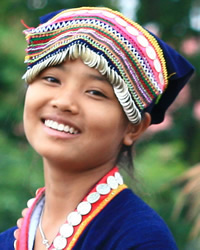Khmu in Thailand

Photo Source:
Anonymous
|
Send Joshua Project a map of this people group.
|
| People Name: | Khmu |
| Country: | Thailand |
| 10/40 Window: | Yes |
| Population: | 16,000 |
| World Population: | 911,200 |
| Primary Language: | Khmu |
| Primary Religion: | Ethnic Religions |
| Christian Adherents: | 6.00 % |
| Evangelicals: | 5.70 % |
| Scripture: | Portions |
| Ministry Resources: | Yes |
| Jesus Film: | Yes |
| Audio Recordings: | Yes |
| People Cluster: | Mon-Khmer |
| Affinity Bloc: | Southeast Asian Peoples |
| Progress Level: |
|
Introduction / History
Most of the ethnic groups of northeastern Thailand live in villages along the Mekong River and its tributaries. They speak various languages which come from either the Mon-Khmer or Tai group. Most of the people are bilingual, speaking both their own language and one of the Tai or Lao languages. China is the original homeland of most of these tribes. They gradually migrated southward due to pressure by the Chinese. As they traveled, they conquered many peoples along the way. By the tenth century, a large number had settled in Thailand.
Northern Thailand is the site of the early Mon Kingdom, which was founded in the sixth century. In the thirteenth century, the Thai conquered this kingdom. In the early part of the nineteenth century, the Thai forced the Mon to leave their homes and move to the Mekong River region. Today, these tribes live along both sides of the river. They are far less powerful than the dominant Lao and Thai peoples nearby, but each tribe has some of their own distinctives. Sometimes it is their language and sometimes it is the way they dress.
The Khmu people live primarily in Laos and Vietnam, but smaller numbers live in southern China or Thailand. There are also diaspora communities in the United States and France.
What Are Their Lives Like?
Tribal peoples in Southeast Asia, like the Khmu, are primarily rice farmers, though they usually do some fishing and hunting as well. They have special storehouses for rice. These are elevated to keep mice from eating it. The Khmu cultivate a wide variety of crops, including various fruits and vegetables, for both consumption and trade. Like other Southeast Asian tribes, the Khmu work communally to maximize their productivity, but each family has their own private garden as well. These tribes are poorer than the dominant ethnic groups and therefore depend on them for many goods and services. Khmu villagers frequently meet with the Thai to trade their farm goods for necessary items such as clothing and salt. It is becoming more common for the Khmu people to raise pigs, goats, water buffalos, and other livestock to sell the meat.
Over the years, the tribes began adopting the practices of the surrounding peoples. This brought on many significant changes within their cultures. For example, they no longer use their traditional farming methods of burning and clearing plots. Instead, they grow wet-rice on terraced plots, which is the agricultural method of the Thai. They also raise their cattle and till their fields. They prepare the fields with plows drawn by buffalo or oxen. Other Khmu people are farmhands, weavers or blacksmiths.
They usually made Khmu houses of wood or bamboo, but they are now using metal roofing. They build them on stilts above the ground, with farmlands next to the residential areas. Domestic fowl, pigs, and goats may run freely underneath these houses.
Among the Khmu, the village is the most significant political unit of society. A headman leads each village, and the father leads each family.
What Are Their Beliefs?
The Khmu are officially Buddhist. However, most have mixed elements of Buddhism with traditional animistic beliefs (the belief that non-living objects have spirits). For this reason, the people often seek help through supernatural spirits and objects. They rely heavily on spirit doctors, whom they believe have great healing powers. They also depend on shamans.
Ancestor worship (praying to deceased ancestors for provision and guidance) is also common among the Khmu people. They believe the ancestral spirits cause illnesses if we do not appease them. Families usually have small altars near their homes where they make sacrifices and offerings to the spirits. The people believe each village has a guardian spirit, as well as various spirits that are linked to the elements of nature. Each family believes they are protected by a sacred totem represented by a boar, an eagle or another animal.
The Khmu keep amulets and charms hanging on the village gates to ward off fires, storms and other natural disasters. Families often have these on the doorways of their homes as well. Only a priest may touch these sacred objects.
Among the tribes of this region, the Khmu are the most spiritually respected. This is because the Thai and the Lao believe the Khmu have a closer link with the land and its spirits than other people groups.
What Are Their Needs?
The Khmu people need to put their faith in Christ alone. The spirit world cannot help them with either their physical or spiritual needs.
Prayer Points
Pray for the Lord to give the Khmu people in Vietnam an abundant harvest this year as a testimony of his power and love.
Pray for the Khmu people to have hearts that are open to the abundant blessings of Jesus Christ.
Pray for their families to prosper financially and spiritually as they experience a relationship with Jesus Christ.
Pray for a movement to Christ among the Khmu that will spread joy, peace and salvation to other peoples throughout Southeast Asia.